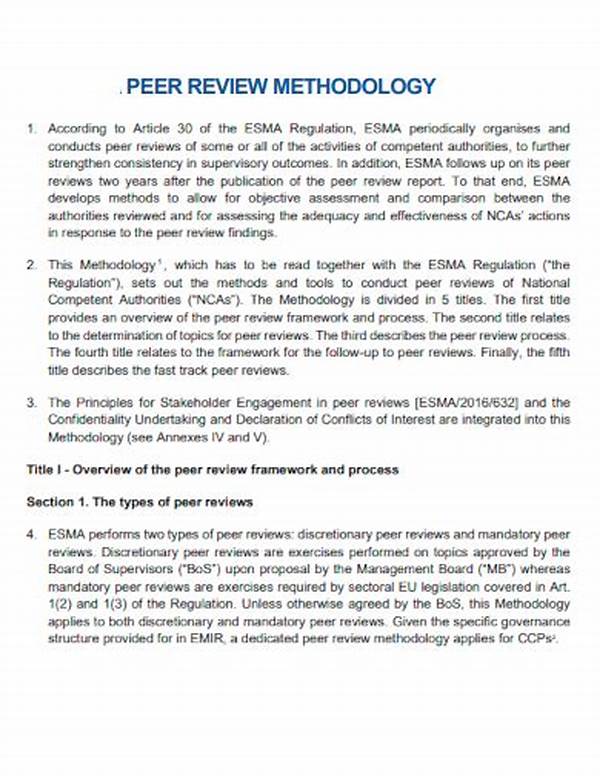In the ever-evolving landscape of academic and scientific research, peer review remains a cornerstone for ensuring the credibility and quality of published work. As the volume and complexity of research outputs increase, the need for innovative peer review methodologies becomes more compelling. These methodologies aim to address existing limitations, enhance transparency, and improve the overall efficiency of the peer review process. This article delves into various aspects of innovative peer review methodologies, exploring their significance and the transformative potential they hold for the scientific community.
Read Now : Bibliometric Evaluation Methods
The Role of Technology in Peer Review
The integration of technology into peer review processes has been pivotal in developing innovative peer review methodologies. Technology facilitates a more dynamic and interactive review process, enabling real-time collaboration and feedback. Platforms utilizing artificial intelligence and machine learning have been employed to optimize reviewer matching, detect ethical issues, and even predict the potential impact of research findings. Moreover, blockchain technology is being explored to ensure the integrity and traceability of review histories. These advancements not only streamline the review process but also enhance its transparency and accountability, thus fostering a more trustworthy scholarly communication ecosystem. Innovative peer review methodologies enabled by technology are restructuring traditional practices, setting new standards for quality and efficacy in scientific discourse.
Key Principles of Innovative Peer Review
1. Transparency: Innovative peer review methodologies emphasize openness, allowing authors and reviewers to interact directly while maintaining confidentiality.
2. Efficiency: By leveraging technology, these methodologies streamline the review process, reducing time from submission to publication.
3. Accountability: Modern methodologies often incorporate systems to ensure reviewers adhere to ethical standards and provide constructive feedback.
4. Inclusivity: Broader participation is encouraged, drawing from diverse expert pools to enrich the review process with multiple perspectives.
5. Flexibility: Innovative approaches allow for adjustments in review protocols, catering to the specific needs of different disciplines and publication formats.
Traditional vs. Innovative Peer Review
Traditional peer review processes have long been criticized for their lack of transparency, potential biases, and lengthy timelines. In contrast, innovative peer review methodologies aim to address these critiques by introducing more agile, responsive, and equitable review systems. Open peer review, for instance, allows for greater visibility of reviewer comments and author responses, fostering an environment of accountability and mutual respect. Furthermore, post-publication peer review provides an ongoing evaluative process, wherein the broader scholarly community can engage with published work, contributing additional insights and identifying errors or inconsistencies that may have been overlooked initially. These evolving models reflect a paradigm shift, empowering both authors and reviewers in ways that traditional systems have often constrained.
Read Now : Evaluating Outcomes Of Diverse Research Teams
Benefits and Challenges of Innovative Approaches
Innovative peer review methodologies offer numerous benefits that align with the evolving needs of the scholarly community. Firstly, they enhance the speed and efficiency of the review process, addressing the common critique of publishing delays in traditional systems. Secondly, the increased transparency inherent in new methodologies builds trust within academia, attracting a more diverse range of contributors to the scholarly dialogue. However, implementing such approaches is not without its challenges. Technology-driven peer review systems require significant investment and infrastructure, which may be prohibitive for smaller publishers or institutions. Moreover, the shift towards openness in peer review could face resistance from stakeholders accustomed to anonymized, closed procedures. Despite these hurdles, ongoing dialogue and iterative refinement of methodologies hold promise for surmounting these obstacles, thereby realizing the full potential of innovative peer review methodologies.
Case Studies and Applications
In examining the practical application of innovative peer review methodologies, several case studies illuminate their effectiveness and adaptability. Journals adopting open peer review report improved author satisfaction, attributable to clearer communication and faster feedback loops. Meanwhile, post-publication review platforms have successfully harnessed the collective intelligence of global research communities to refine and validate research findings. Additionally, machine learning algorithms in reviewer selection are minimizing biases and enhancing the alignment of reviewer expertise with manuscript content. These examples underscore the versatility of innovative methodologies in diverse contexts, highlighting their potential to revolutionize the peer review process.
Bridging Gaps with Technology
The gap between traditional practices and modern expectations in peer review is increasingly being bridged by technology. Online platforms offer seamless interfaces for submitting and reviewing manuscripts, while data analytics provide insights into reviewer performance and decision accuracy. Innovative peer review methodologies are therefore not only advancing the logistical aspects of review procedures but are also enriching the intellectual engagement between authors, reviewers, and readers. As such, stakeholders in the academic publishing ecosystem must remain open to embracing these technological advancements, thus enhancing the quality and robustness of scholarly communication.
Conclusion
The emergence of innovative peer review methodologies marks a significant transformation in the realm of academic publishing. As these methodologies continue to evolve, they promise to address the inherent challenges of traditional peer review systems, such as opacity, subjectivity, and inefficiency. By leveraging technological advancements and promoting a culture of transparency, these innovative approaches lay a solid foundation for a more equitable and effective scholarly communication process. Stakeholders within the academic community should actively engage with these novel methodologies to fully realize their potential, ensuring the integrity and impact of future research endeavors.
